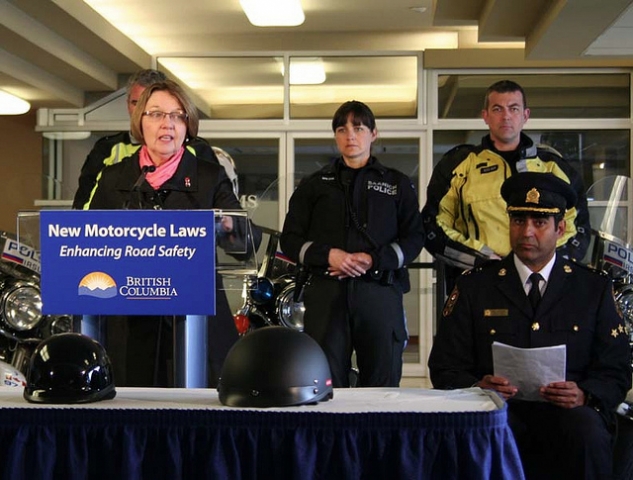Province announces changes to motorcycle laws to boost rider and passenger safety
The Province is getting tough on riders who like to use novelty helmets by introducing new motorcycle safety regulations that requires all riders to wear protective headgear that meets international safety standards.
“While B.C. already has mandatory helmet and seating laws, these new standards provide even more guidance to help riders — who are more vulnerable to injury and death than other road users —enjoy a safe journey,” said Minister of Justice and Attorney General Shirley Bond Monday from Victoria.
Effective June 1, all motorcycle riders and their passengers must wear helmets that meet safety industry standards.
This means motorcycle riders will no longer be able to wear novelty helmets, typically known as skidlids, skullcaps or beanies, which do not meet the new requirements.
The new laws will also require passengers, including children, to place their feet on foot pegs or floorboards.
Children who are unable to reach footrests will no longer be allowed to ride as passengers.
The provincial government intends to move forward with a graduated licensing program that includes power restrictions, following additional consultation to determine the best model.
“Police have been asking for these changes for years,” said Jamie Graham, chair, BC Association of Chiefs of Police Traffic Safety Committee.
“We have seen the harm that inadequate safety equipment and poor choices cause.
“You have to be responsible for your actions, dress appropriately, pay attention and focus on driving, and you will prevent a tragedy.”
Bond said the goal is to reduce fatalities and injuries from crashes involving motorcycles.
While motorcycles are estimated to make up about three per cent of insured vehicles in B.C., they account for approximately 10 per cent of road fatalities.
In the last five years, 203 motorcyclists have lost their lives on B.C.’s roads and 5,172 have been injured.
Motorcycle fatalities increased by about 57 per cent between 1996 and 2010.
“The new safety requirements will save lives,” Dr. Roy Purssell, emergency physician and chair of the BCMA’s Emergency Medical Services Committee said.
“When motorcycles and vehicles collide, the rider of the motorcycle is the one most often seriously injured or killed.
“I have provided care for motorcyclists who arrive at the emergency department with minimal injuries after surviving a terrible crash simply because they were wearing a well-designed helmet and other protective gear.”
The new rider safety regulations are the result of extensive consultations between the Office of the Superintendent of Motor Vehicles, BC Coroners Service, ICBC, police and other road safety partners to develop a comprehensive approach to improve motorcycle safety within the motorcycling community and industry.
The month of May will allow for a transition period that will give government time to move to the new laws by informing riders and the public about the upcoming changes.
Starting June 1, police will begin enforcing the new laws and issuing educational materials to riders found violating the helmet and seating regulations.
Fines for all new helmet-related offences are $138, and fines for seating requirements range from $109 to $121. In addition to fines, riders violating seating requirements will have their motorcycles impounded.
Quick Facts:
- Helmet laws have been found to reduce fatalities by as much as 37 per cent.
- Each year in B.C., there are about 2,200 crashes involving motorcyclists and about 42 rider deaths.
- Motorcyclists are eight times more likely to be killed and more than 40 per cent more likely to be injured in a crash than other road users.
- The main factors contributing to motorcycle crashes are speed, an inattentive driver and failure on the part of other drivers to yield to right-of-way of motorcyclists.
- Helmets that meet industry standards have a rigid head covering with a strong, stiff outer shell and a crushable liner. The stiff outer shell protects the head by distributing the impact throughout the surface of the helmet, and the crushable liner protects the head by being able to absorb the energy of the impact. Full-face helmets are not mandatory.
- Helmets must comply with standards outlined by the United States Department of Transportation (DOT), Snell Memorial Foundation 2005 or 2010, or United Nations Economic Commission for Europe (ECE).


























Comments